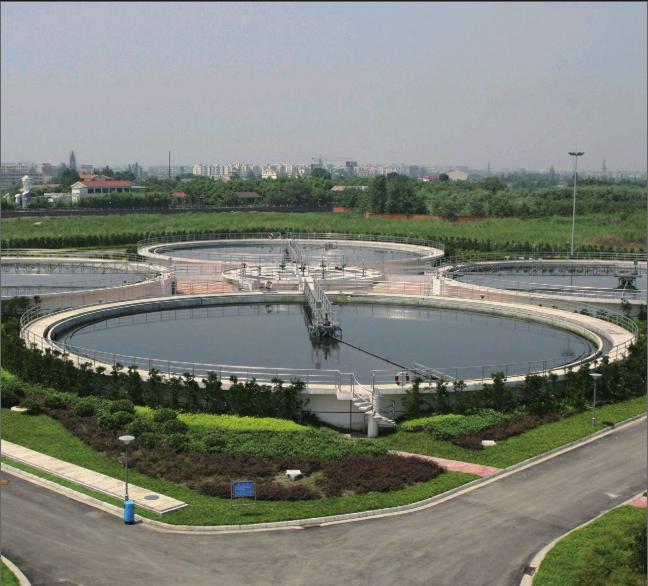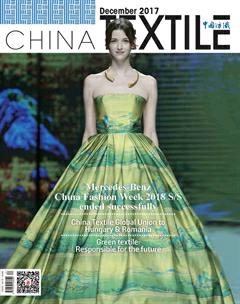Green textile:Responsible for the future

No matter it is because of the increasingly pressurization of the national energy-saving and environmental protection policies in recent years, or the shut down of dyeing and printing enterprises for reorganization in Keqiao, Wujiang, Shishi ... one after another, or the continuous prize rise of dyes to “make things even worse”, the throes of the structural regulation of the industry becomes more intensified and the green transformation of the textile industry is quite urgent. Just as the president of China National Textile and Apparel Council - Sun Ruizhe has said: “in a world with fast change, deep connection, opposite and unified and full of unknown, Chinese textile industry must accelerate its steps of transforming and upgrading from the traditional industry into the innovationdive scientific and technological industry, green industry led by responsibility and culture-oriented fashion industry.”
In the face of the industrial transformation and upgrading as well as the construction of the strong textile countries, how to promote the textile industry stably in the future? This happens to hold the same view with the point mentioned by President Xi Jinping in the 19th National Congress that construction of the ecological civilization is the onethousand year plan of the sustainable development of Chinese nation.
The “12th Five-Year Program” on green development has significant achievements
In mentioning the green development of the textile industry, dyeing and printing is the topic mostly unable to be avoided. As an intensive industry in discharging sewage, energy and water consumption, the dyeing and printing industry is the front position for the energy saving, emission reduction and green development of the textile industry. It is also the pioneering industry of techni-cal innovation and responsibility development, the strategic tongs of the textile industry to provide service for the overall situation and win the future. Therefore, green dyeing and printing has become a key step in the green transformation and improvement of peoples livelihood in the future of the industry.
For this purpose, the dyeing and printing industry puts forward structure optimization positively to promote the technical and administration levels. In the total manufacturing process, it tries to reduce the resource and energy consumption and the pollutant generation. Meanwhile, it accelerates the strength of end treatment, to promote the pollutant treatment level. The energy conservation and emission reduction of the industry has realized significant effect. In the “12th Five-Year Program”period, the water consumption of the unit product in the dyeing and printing industry has decreased 28%, from the original 2.5 tons/hectometre into 1.8 tons/hectometre. The comprehensive energy consumption of the unit product has also decreased 18%, from the original 50 kg standard coal/hectometre to 41 kg standard coal/hectometre. And the repeating utilization factor of the water in the printing and dyeing industry has also improved from 15% to 30%, which is an increasing of 15%. In 2010 - 2014, the dyeing and printing industry wed out the lagged capacity of 11.6 billion meters, saved water for an accumulative 230 million tons and reduced the waste water discharging of 360 million tons.endprint
Not only that, in 2011 - 2016, the main business income and total profit of the dyeing and printing enterprises with scales also had a gradual growth tendency. Its main business income has increased from the 328.099 billion RMB in 2011 into the 393.717 billion RMB in 2016, with an average annual growth of 3.09%. The total profit has increased from the 15.228 billion RMB in 2011 into 20.979 billion RMB in 2016, with an average growth of 5.50%. The sales profit rate always keeps around 4% - 5% ... This series of data illustrates forcefully that the dyeing and printing industry is moving into the fast traffic lane of sustainable development through the industrial structure regulation steadily.
In addition to the supervision of the government and the guidance of the association, this is because of the leading of the enterprises and the self-consciousness of the social responsibility awareness. In 2014, the R&D appropriation expenditure of the large and medium textile enterprises in China was 25.7 billion RMB, which was increased 81% than that of 2010. The research input strength was 0.67%. The quantity of the effective patents was 5,381 pieces, which was 2.3 times of that of 2010. In the “12th Five-Year Program”period, 529 scientific and technological achievements won The Scientific and Technological Prize of CNTAC; 16 achievements won the National Scientific and Technological Prize. Thereinto, “Cheese Digitization Automatic Dyeing Packaged Technology and Equipment” won the first prize of the National Scientific and Technological Award. A total of 25 technologies, including the ultralow liquor ratio high temperature and high pressure, green dissolving pulp making engineering technology and so on were listed into the catalog of the country in encouraging industrial water-saving technology, technique and equipment. LHTHAI, YUYUE, PACIFIC and a large batch of other demonstrating enterprises with the technology of energy-saving, emission-reduction and the comprehensive utilization of resources take the positive boosting function in the aspects of leading the industry in water saving, emission reduction and green development.
The textile industry is still progressing on the road of ecological civilization construction
Confronting the future development of the industry, The “13th Five-Year Program” Development Schema for the Textile Industry has already outlined a clear road map of green production for a long time. “As a traditional pillar industry with the capacity scale exceeding 1,000 billion USD in the national economy, the manufacturing civilization construction of the textile industry must be placed in an important position. This is also one of the five key works of the textile industry in China to practice “Made in China 2025”. Sun Ruizhe still emphasized in summarizing the green development path of the textile industry in the recent years:“green development is listed in parallel as one of the four basic principles in schema formulation together with market orientation, innovation motivation and structure optimization. The strengthening of the ecological civilization construction is listed as one of the sixth most important tasks in the “13th Five-Year Program” period. The low-carbon energy saving project, green environmental protection project and fiber circulation project will be the key projects of the planning, which will be emphasized to be promoted in the “13th Five-Year Program”period. The future textile ecological civilization construction will be concentrated on enhancing the capability construction and instrument construction, thus promoting the ecological civilization construction with practice.”endprint
As a big user in water consumption and emission, the textile industry is ought to assume more social responsibility on the road of setting up the ecological civilization construction. The ecological civilization construction must be integrated into the industry governance and enterprise management, because the textile value chain itself is an“ecological system”. As a matter of fact, in the past ten years, the issuance of the social responsibility management system CSC9000T of the textile industry and the publication of the social responsibility report have already made its due contributions and established good examples to the ecological civilization construction of the industry with foresight
Nowadays, green production is imperative. The sustainable development has become the common aspiration of the industry. The ecological civilization is not only the purpose, but also the important strategic support of the sustainable development. For this, in the “13th Five-Year Program” period, the textile industry must strengthen the energy saving and emission reduction management system as well as the construction of the technical system, improving the basic condition of the ecological civilization construction. It is required to promote the establishment of the carbon emission right, energy saving and emission reduction transaction system, energy saving and low carbon product certification system as well as other marketization energy conservation and emission reduction mechanisms, so as to further improve the clean manufacturing system, perfect the relevant standards and strengthen the clean manufacturing audit and performance assessment. Meanwhile, it is also vital to accelerate promoting the enterprises to develop the green manufacturing technology, explore green textile products and popularize the application of the energy conservation and emission reduction technology. Moreover, people must explore green textile products, promote ecological design and guide green manufacturing, accelerate the promotion of the green consumption model, establish the perfect standards as well as laws and regulations, establish the recycling and re-utilizing system of the waste textile products.
Green production to realize the sustainable development
The popularization and application of the advanced technology is undoubtedly the key of supporting the green production of the industry. In the “13th Five-Year Program” period, the manmade fiber industry emphasizes to develop the technology of extracting organics from the polyester esterification waste water, the key technology of stoste coloring and on-line adding. The viscose glue industry develops the green pulping and pulp-fiber integrated technology and so on. The spinning and weaving area accelerates the promotion and using of variable frequency motor and energyefficient air conditioning, promotes the large package two-for-one twister, batcher as well as the new starching technologies of no PVA starching, prewet starching and so on. In particularly, the printing and dyeing industry will devote greater efforts to promote the water pollution control and the resource comprehensive utilization technology, less water and no water printing and dyeing processing technology, digitization and intelligent control technology as well as other green processing technologies. In addition, it will develop the recycling and cyclic regeneration technologies of the waste products, such as the waste clothes, home textiles and industrial textiles, break through the pollutant treatment and resource re-utilization industrial technologies of the waste gas, waste water and sludge and other pollutants, so as to make sure that the energy conservation and emission reduction targets of unit industrial added value energy consumption, water consumption, emission amount of the main pollutants, emission strength of industrial carbon reach the national binding indexes and the relevant standard requirements.endprint
We will strive to realize that the cyclic utilized textile fiber quantity will keep on increasing in the “13th Five-Year Program” period. In 2020, it will be expected to reach 12 million tons, occupying 20% of the total fiber processing amount. The recycling and comprehensive utilization rate of the waste textiles and clothes reach 30%. The textile unit industrial added value energy consumption has an accumulative decrease of 18%. The unit industrial added value water intaking has an accumulative decrease of 23%. The total emission volume of the main pollutants decreases 10%.
“In order to strengthen the innovation and research of the clean manufacturing technology and realize the green development, it is necessary to break through the key great technology and leading technology of clean manufacturing, advocate the advanced and appropriate technology. In particularly, through strengthening the combination involving production teaching and research, introducing and cultivating high-end talents can develop the high and new technology, realize the scientific and technological innovation from “0”to “1”, stimulate new vitality, create new commercial activity and display the new image.” In recent days, the vice president of CNTAC - Li Lingshen expressed in the dyeing and printing environmental annual meeting that: in order to realize the green industrial manufacturing, it is still required to strengthen the construction of the green supply chain of the textile industry, especially the collaboration. The environmental protection work requires more the transboundary integrating, crowd-sourcing implementation of the upstream and downstream of the industrial chain, so as to obtain a good result.
Standing on the new starting point and confronting the new situation, the textile industry can realize the sustainable development and accomplish the new pattern of future development only it practices the green idea and assumes the social responsibility actively.endprint

